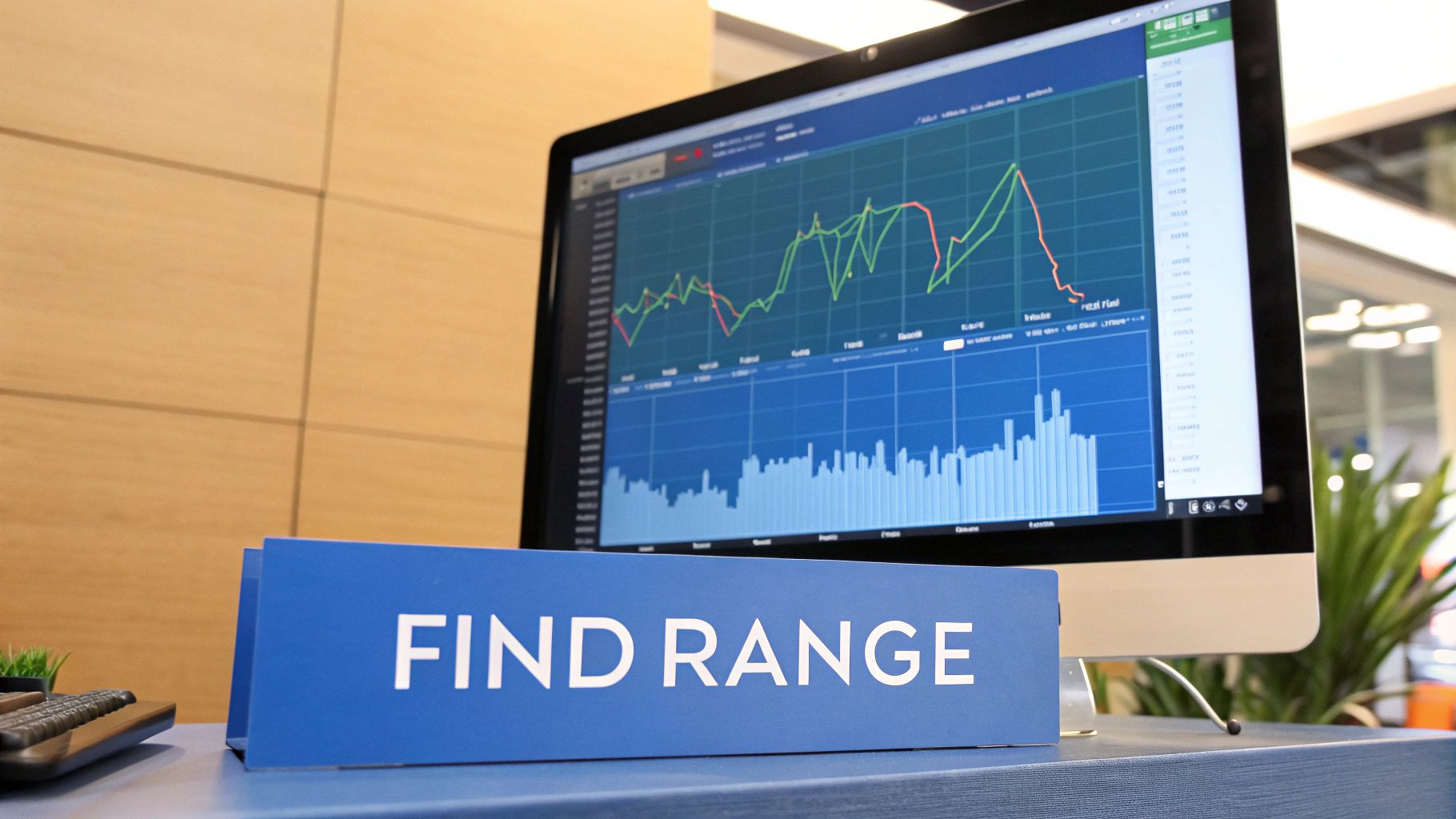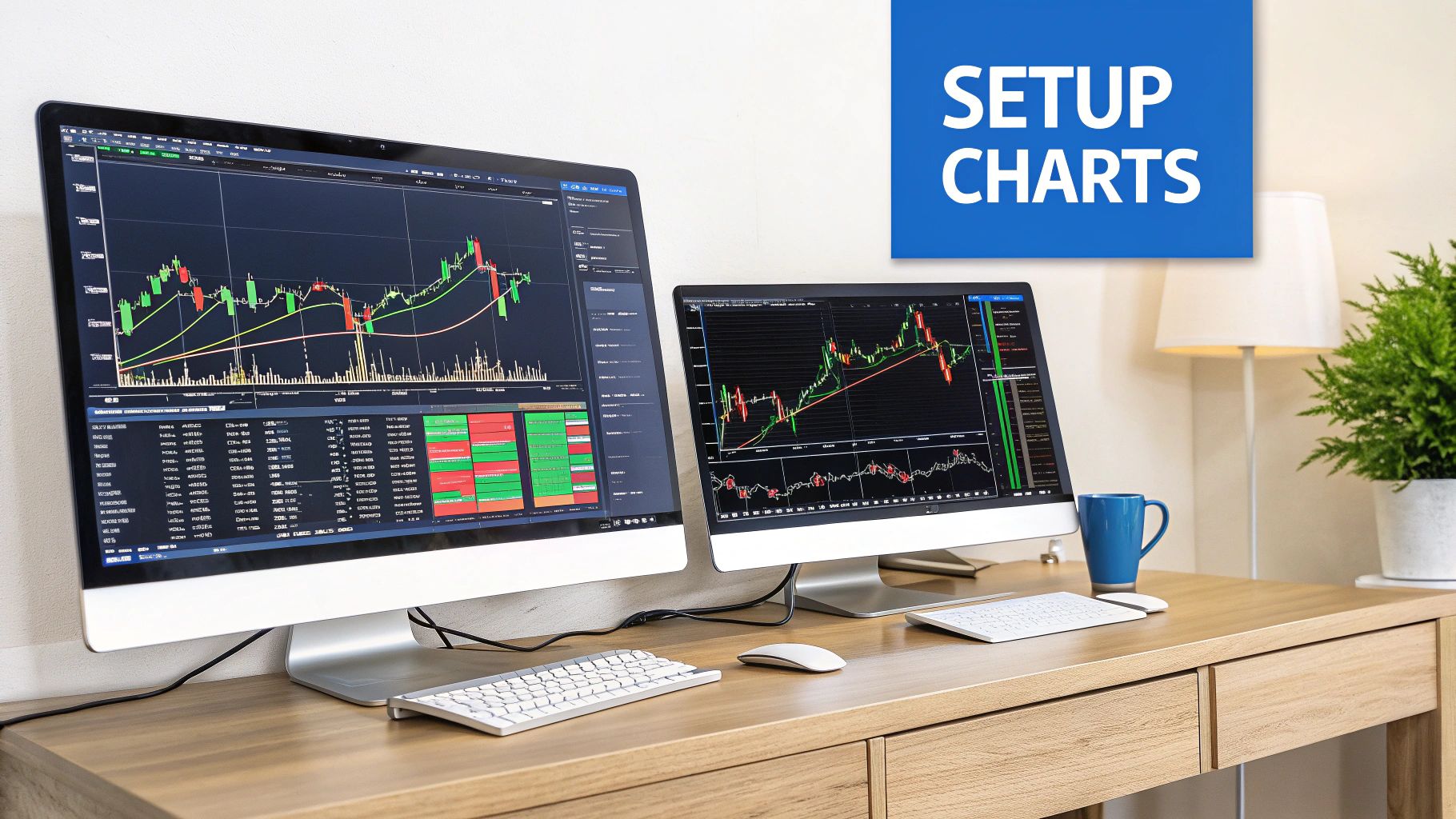Master the Opening Range Breakout Strategy in Trading
The Power Behind Opening Range Breakouts

The opening range breakout strategy is a time-tested trading approach. It's based on observing predictable market behaviors, particularly during the opening minutes of trading. This period often offers valuable insights into the day's potential market direction.
This strategy centers around the opening range, the highest and lowest prices established during this initial period. These highs and lows frequently act as key support and resistance levels. A break above the opening range high often suggests a bullish trend, while a break below the opening range low may indicate a bearish trend.
Why the Opening Range Matters
The first 30 minutes of trading are typically characterized by high activity and liquidity. Traders react to overnight news, economic data releases, and pre-market sentiment. This creates significant price fluctuations, providing opportunities for traders. However, the opening range can be adjusted to different timeframes to suit various trading styles and markets.
The History and Evolution of the ORB
The Opening Range Breakout (ORB) strategy, developed by traders like Arthur Merrill in the 1960s, has long been a staple in day trading. Its historical success is often linked to the increased liquidity and strong market sentiment during the opening hours. Consider the S&P 500, where the first 30 minutes are crucial for defining the opening range.
Recent backtests, however, show that the ORB's effectiveness has declined due to its widespread use. To counteract this, traders are now using additional filters and integrating broader market trends to improve profitability. Despite its diminished edge, the ORB's clear entry and exit points make it a popular choice for navigating the markets. Learn more about this strategy here. This adaptation highlights the importance of continuously refining the ORB to maintain its relevance in today's market environment.
Crafting Your Opening Range Breakout Framework
Building a robust opening range breakout (ORB) strategy requires more than just spotting basic setups. It demands a personalized framework tailored to your individual trading style and the specific market you’re trading. This means carefully choosing the right timeframe for your ORB, configuring your charts effectively, and, critically, implementing a sound risk management plan.
Selecting the Right Timeframe
The classic 30-minute opening range remains a popular choice, particularly for equities like the S&P 500. However, different timeframes can offer advantages for other markets and trading approaches. For the rapid-fire world of futures, such as the E-mini, a 15-minute or even 5-minute opening range might be more suitable. The 24-hour Forex market, on the other hand, often responds well to a 1-hour opening range synchronized with major market openings like London or New York. Selecting the appropriate timeframe is key for filtering out market noise and identifying true breakouts.
To help visualize the different timeframes and their ideal uses, take a look at the comparison table below:
Opening Range Timeframes Comparison
| Timeframe | Best Markets | Advantages | Disadvantages | Recommended For |
|---|---|---|---|---|
| 5-minute | Futures (e.g., E-mini) | Captures very short-term moves; suitable for scalping | Prone to false breakouts; requires quick execution | Day traders, scalpers |
| 15-minute | Futures, fast-moving stocks | Balances speed and accuracy; good for day trading | Can still experience some whipsaw | Day traders, swing traders |
| 30-minute | Equities (e.g., S&P 500) | Traditional timeframe; often reliable | Slower to react to breakouts | Swing traders, position traders |
| 1-hour | Forex | Aligns with major market sessions; suitable for longer-term ORB trades | May miss short-term opportunities | Swing traders, position traders |
This table highlights the nuances of each timeframe and can assist in choosing the best fit for your trading strategy and target market. Remember, there’s no one-size-fits-all solution. Experimentation is key to finding what works best for you.
Chart Configuration for Breakout Identification
Spotting breakouts accurately requires configuring your charts with the right tools. Clearly marking the high and low of the opening range is essential. This can often be automated with platforms like ChartsWatcher. Adding volume indicators can help confirm breakout strength. High volume during a break suggests strong conviction, while low volume can indicate a false breakout.
Mastering Risk Management for ORB Trades
Risk management is paramount for any trading strategy, especially ORB. Define your stop-loss strategy before entering a trade. A common practice is placing the stop-loss just below the opening range low for long entries, or just above the high for short entries. Position sizing is equally critical. Determine the appropriate amount of capital to risk per trade, often expressed as a percentage of your account (e.g., 1% or 2%).
Finally, set realistic profit targets based on market volatility. Using a fixed risk-reward ratio, aiming for potential profit that's a multiple of your risk (e.g., 1:2 or 1:3 ratio), is a good approach. This structured approach turns the theoretical ORB concept into practical trading decisions, equipping you to navigate market complexities and potentially improve trading outcomes.
The Data-Driven Edge of Opening Range Breakouts

While the mechanics of opening range breakouts (ORBs) might appear simple, the real advantage lies in understanding the underlying data. This involves looking beyond the daily highs and lows and delving into the statistical patterns that make the first hour of trading so important. This data-driven approach helps traders form realistic expectations and refine their ORB strategy for consistent profits.
Volatility Signatures and Price Discovery
The first hour of trading often displays distinct volatility signatures. These price swings aren't random. They represent a crucial period of price discovery where the market processes overnight news and pre-market sentiment. This volatility presents opportunities for traders who can identify emerging patterns and anticipate subsequent breakouts. For example, higher-than-average opening range volatility may indicate increased breakout potential. Conversely, lower volatility could suggest a greater chance of false breakouts.
Market Cap, Sector Analysis, and ORB Effectiveness
ORB strategies vary in effectiveness across different market capitalizations and sectors. Large-cap stocks, for example, tend to have more predictable opening range behavior than smaller, more volatile companies. Certain sectors may also be more susceptible to opening range breakouts based on news cycles and industry-specific factors. By studying historical data, traders can adapt their ORB strategy to specific markets and sectors, increasing their likelihood of success.
Furthermore, a study by Grimes, which analyzed 46,000 daily bars from stocks, futures, and currencies, emphasized the importance of the market open. The research showed that the open price often clusters near the daily highs or lows. This suggests a non-random pattern traders can potentially use to their advantage. This observation lends credence to ORB strategies, which capitalize on breakouts from these initial ranges. Find more detailed statistics here. While the effectiveness of basic ORB strategies has diminished due to wider adoption, incorporating market context and other indicators can still lead to profitable trades, especially in liquid markets like the S&P 500 or E-mini futures.
From Pit Trading to Algorithms: The Evolution of ORBs
ORBs have a long history, adapting alongside the market. Historically, pit trading fostered a concentrated period of price discovery. Today, electronic markets and high-frequency trading algorithms like those used on ChartsWatcher have dramatically changed market dynamics. However, the basic principle of ORBs—capitalizing on the first hour's volatility—remains important. This continued relevance stems from the fact that even in today's algorithmic markets, the opening range provides valuable insights into the day's potential direction.
Managing Diminishing Returns and Finding the Edge
It's important to recognize that the popularity of basic ORB strategies has sometimes resulted in diminished returns. This doesn't mean ORBs are obsolete; it highlights the need for adaptation. By incorporating additional filters, such as volume analysis and market context, traders can still find high-probability setups. Focusing on specific market conditions where ORBs still perform well, such as liquid markets or particular sectors, is also critical for maintaining an edge. This more nuanced, data-driven approach enables traders to develop a more robust and profitable ORB strategy.
Spotting the Highest-Probability Breakout Setups

Not all breakouts are created equal. Some quickly fade, while others spark significant trends. This section explores how seasoned traders pinpoint opening range patterns with the best chance of success. This involves considering several important factors, including pre-market activity, overnight price action, and the nature of the opening range itself.
Analyzing Pre-Market Activity and Gaps
Pre-market trading offers valuable insights into potential breakouts. Significant price changes or unusual volume before the market opens can signal strong momentum during regular trading hours. Gaps, where the opening price differs significantly from the previous day's close, also hold importance.
A gap up can suggest strong buying pressure, while a gap down may indicate selling pressure. However, gaps can sometimes be filled. It's important to analyze them within the context of the overall market. A gap up coupled with high pre-market volume presents a much stronger signal than a gap up with low volume.
Interpreting Market Internals During the Opening Range
The first few minutes of trading are critical for understanding market internals. Professional traders look for signs of conviction in the initial price movements. Is volume supporting the price action? Are large orders being placed?
These clues help differentiate potential trend days, where the market moves decisively in one direction, from choppy consolidation, where the price fluctuates within a tight range. Recognizing this difference is essential for effectively using the opening range breakout strategy.
Identifying Trend Days and Volatility Thresholds
A key statistic regarding the opening range breakout strategy is its performance on likely trend days. These are days marked by significant price moves in one direction, often triggered by news or market events. Experts like Toby Crabel and Mark Fisher emphasize the importance of identifying these trend days.
For example, during periods of high volatility (sometimes referred to as "two sigma days" for E-mini S&P futures), opening range breakouts tend to perform better, aligning with the overall market direction. Keep in mind that the increasing popularity of this strategy has led to diminished returns for simpler implementations. Explore this further here. You might also find this helpful: 8 High-Probability Trading Setups.
Market Conditions and Seasonal Tendencies
The effectiveness of the opening range breakout strategy can vary based on market conditions and seasonal tendencies. Certain times of the year, such as earnings season, may experience heightened volatility, leading to more breakout opportunities.
Likewise, specific market conditions, such as high overall market volatility or sector-specific news, can greatly influence the strategy's success rate. Understanding these factors enables traders to adapt their strategies and focus on the most promising setups. By honing these identification techniques, traders can refine their pattern recognition skills and focus on the highest-probability trades. This facilitates better decisions about when to employ the opening range breakout (ORB) strategy and when to consider other approaches.
Advanced Techniques That Elevate Your Breakout Trading
Building on the basics of the opening range breakout (ORB) strategy, let's explore some advanced techniques to boost your trading performance. These refinements distinguish professional traders from amateurs and offer a more nuanced approach. For a solid foundation, you might be interested in How to master the Breakout Trading Strategy to Maximize Gains.
Momentum Confirmation Tools
Simply breaking above the opening range high or below the low isn't always a guarantee of success. Confirming the breakout with momentum indicators can significantly improve your win rate. The Relative Strength Index (RSI), for example, can help spot overbought or oversold conditions, filtering out weaker breakouts.
Volume analysis also plays a key role in confirming the move's strength. High volume during a breakout often signals strong conviction, increasing the likelihood of success. Low volume, on the other hand, can indicate a false breakout, suggesting a potential price reversal.
Order Flow Analysis and Multi-Timeframe Validation
Professional traders frequently use order flow analysis in their ORB strategies. Examining the order book during the opening range can reveal underlying buying and selling pressure. For instance, observing large buy orders at the ask price during a breakout reinforces bullish sentiment.
Validating breakouts across multiple timeframes adds another layer of confidence. A breakout on a shorter timeframe (like the 5-minute chart) confirmed by a longer timeframe (like the 30-minute chart) offers a stronger signal. This ensures the breakout aligns with the broader market trend.
Adapting to Volatility Regimes
ORB strategies need to be adjusted for different volatility environments. In low-volatility markets, tighter stop-losses and more selective entries are crucial. Filters, like waiting for a larger percentage break of the opening range (say, 3%), can help weed out weaker setups.
In high-volatility markets, wider stop-losses are needed to accommodate bigger price swings. However, this increased volatility can also present greater profit potential. Adjusting your position sizing based on volatility can help optimize risk and reward.
Advanced Breakout Patterns: Inside-Outside Days and Failure Tests
Beyond the basics, experienced traders often look for specific patterns. Inside days, where the daily high and low fall within the previous day's range, can signal potential volatility contraction before a significant breakout. Outside days, which encompass the previous day's range, can suggest increased volatility and potential trend continuation.
Failure tests offer another interesting setup. This occurs when the price breaks the opening range but quickly reverses and retests the broken level. These can provide excellent entry points. A long entry might be considered after a failed breakdown below the opening range low. This offers a second entry opportunity with a tighter stop-loss. These strategies can be further examined using tools like those available at ChartsWatcher.
Institutional Trap Setups
Identifying institutional traps is a more advanced technique. These are designed to ensnare less experienced traders. Understanding how institutional traders influence price action during the opening range can give you an asymmetric advantage.
One common tactic involves pushing the price below the opening range low to trigger stop-loss orders before reversing and driving the price higher. Recognizing these patterns requires close observation of order flow and price action. By mastering these advanced techniques, you can refine the basic ORB strategy into a more sophisticated and profitable approach.
| Market Condition | Win Rate | Average Profit/Loss | Max Drawdown | Optimal Approach |
|---|---|---|---|---|
| Low Volatility | 45% | 2% | 5% | Tighter stops, larger percentage breakout confirmation (e.g., 3%) |
| High Volatility | 60% | 5% | 10% | Wider stops, adjusted position sizing |
| Inside Day Breakout | 55% | 3% | 7% | Enter after confirmation of range expansion |
| Outside Day Breakout | 65% | 4% | 9% | Trade in the direction of the breakout |
The table above, "ORB Performance Metrics Across Market Conditions," illustrates the statistical performance of opening range breakout strategies in different market scenarios. It provides a quick overview of win rates, average profit/loss, maximum drawdown, and the optimal approach for each situation.
As you can see, adapting your ORB strategy to different market conditions is crucial for success. By understanding these nuances, you can significantly improve your trading outcomes and navigate various market environments effectively.
Opening Range Breakouts in Action: Case Studies

Let's move from theory to practical application by examining real-world examples of the opening range breakout strategy. Analyzing both winning and losing trades provides valuable insights into how this strategy performs in live market conditions. These case studies will explore various trading instruments and market environments, showcasing the adaptability of this powerful strategy.
Case Study 1: Winning Trade - Tech Stock Breakout
This case study focuses on a hypothetical tech stock, XYZ Corp. Imagine XYZ Corp. releases positive earnings news, causing the stock to gap up in pre-market trading. The initial 30 minutes of regular trading establishes a well-defined opening range. The price then breaks decisively above the high of this opening range, accompanied by a noticeable increase in volume. This signals a long entry. A stop-loss order is placed just below the opening range low to manage risk. The price continues to climb throughout the day, eventually hitting a predetermined profit target based on a 1:2 risk-reward ratio. This scenario demonstrates how combining pre-market analysis with a disciplined opening range breakout strategy can lead to successful outcomes.
Case Study 2: Losing Trade - False Breakout in Futures
Now, let's consider a hypothetical trade involving the E-mini S&P 500 futures contract. The opening range displays relatively low volatility. The price breaks above the opening range high, but the accompanying volume is weak, hinting at a false breakout. As suspected, the price quickly reverses, triggering the stop-loss order positioned below the opening range low. This example highlights the importance of confirming breakouts with strong volume and recognizing the increased risk of false breakouts in low-volatility environments. Using tools like those from ChartsWatcher can assist in analyzing volume and volatility.
Case Study 3: Adapting to Choppy Markets - Forex Example
This case study examines a hypothetical EUR/USD forex trade. The market exhibits choppy price action within a relatively wide opening range. Instead of forcing a trade, the trader patiently waits for a clear break and close outside of the established range. This adaptable, patient approach, tailored to the day's market conditions, eventually results in a profitable long entry when the price convincingly breaks above the opening range high with increased volume during the London session. This emphasizes the importance of flexibility and adjusting the opening range breakout strategy to suit prevailing market behavior.
Case Study 4: Failure Test Entry - Index ETF
Let's look at a hypothetical trade on an index ETF (SPY). The price initially breaks below the opening range low but then quickly reverses back inside the range. This “failure test” of the opening range low presents a potential long entry opportunity. A long position is initiated when the price subsequently breaks above the opening range high, confirming a bullish reversal. This case demonstrates how recognizing advanced breakout patterns, like failure tests, can enhance entry points and potentially mitigate risk through tighter stop-loss placement.
By analyzing these real-world scenarios, both successes and failures, traders can gain a deeper understanding of the nuances of the opening range breakout strategy. They can learn to identify high-probability setups, manage risk effectively, and adapt their approach based on the unique characteristics of each trading day. This practical application of the strategy is crucial for developing the pattern recognition skills that can significantly improve trading performance.
Building Your Personalized Breakout Trading Plan
Successfully implementing the opening range breakout (ORB) strategy requires a personalized approach. It's not enough to just understand the basics. Your plan should align with your individual trading style, risk tolerance, and overall market approach. This involves structured planning, detailed record-keeping, and a commitment to continuous improvement.
Pre-Market Preparation and Defining Your ORB
Before the market opens, define your opening range timeframe. Will you use the traditional 30-minute range? Perhaps a shorter 15-minute range for faster-moving markets? Or maybe a longer range for less volatile instruments? Your trading style and the specific market you're analyzing should guide this decision. ChartsWatcher allows you to customize and save these timeframes for consistent application.
Next, outline your entry and exit strategies. Will you enter on a clean break of the high/low? Or wait for a confirming close beyond the opening range? Where will you place your stop-loss? How will you define your profit target? These pre-market decisions provide a structured framework for your trading day.
Trade Journaling and Identifying Hidden Patterns
Maintaining a detailed trading journal is vital for refining your ORB strategy. Record every trade, including entry and exit points, stop-loss and profit target levels, and your reasoning for each decision. ChartsWatcher makes tracking this critical data convenient.
Beyond the basic trade details, document observations about the surrounding market conditions. Was the market trending, consolidating, or volatile? Did the breakout happen on high or low volume? Meticulous analysis of your journal can reveal hidden patterns and improve your understanding of your trading behavior.
Evidence-Based Performance Reviews
Regularly review your trading journal for evidence-based performance assessments. Calculate key metrics like your win rate, average profit/loss, and maximum drawdown specifically for your ORB trades. Analyze which setups perform best and which consistently result in losses.
Also, evaluate your emotional state during each trade. Did fear or greed influence deviations from your plan? Did overconfidence follow a winning streak? Or hesitation after a loss? This honest self-assessment will help you identify weaknesses and improve your psychological discipline.
Integrating ORB Within a Broader Trading Approach
The ORB strategy isn't meant to be used in isolation. It should be part of a comprehensive trading approach. Recognize when conditions favor ORBs and when alternative strategies are more appropriate.
For example, ORBs might perform well in trending markets but be less effective during periods of consolidation. Understanding market conditions and having a diverse set of tools allows you to adapt and improve your chances of success.
Continuous Improvement Through Deliberate Practice
Trading requires continuous improvement. Establish a routine of post-trade analysis and regularly review your trading plan. Stay informed about market dynamics and refine your ORB strategy as your understanding evolves. Consider using backtesting tools, available on platforms like ChartsWatcher, to test variations of your strategy on historical data. This can help identify potential weaknesses and refine your approach before live trading. This deliberate practice is essential for long-term trading success.
Ready to enhance your trading with a powerful, customizable platform? Explore ChartsWatcher today and experience the difference!

